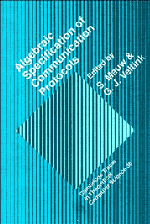Book contents
7 - The Token Ring Protocol
Published online by Cambridge University Press: 03 May 2010
Summary
INTRODUCTION
This case study is a formal description of a protocol for a local area network, using the specification language PSF.
One approach to local networking is the ring network. Although various types of rings have been proposed and built, we will study one of the more popular organizations, the token ring network. In such a network, a token circulates around the ring, which can be captured by one of the components. The component guarding the token is allowed to transmit a message.
The protocol specified in this paper is based on the token ring described in [IEEE85b] as an IEEE standard. This description is given partly in informal, natural language and drawings, and partly by means of state transition systems. The intention of this chapter is to apply a Formal Description Technique in order to give a formal specification of the protocol. In contrast to the protocols in the previous chapters, we try to provide a specification, that resembles an existing standard as much as possible.
TOKEN RING NETWORK, AN INTRODUCTION
A ring consists of a collection of ring interfaces connected by point-to-point links that form a circle, as shown in Figure 7.1. Point-to-point links involve a well-understood and field-proven technology. Due to the sequential ordering of the stations attached to a ring, a ring-based protocol is in general fair in the sense that each station eventually will get control of the ring. In a token ring, each station has a known upper bound on channel access. The ring network standardized in [IEEE85b] is called a token ring and in this section we will take a closer look on what this is.
Information
- Type
- Chapter
- Information
- Algebraic Specification of Communication Protocols , pp. 161 - 178Publisher: Cambridge University PressPrint publication year: 1993
